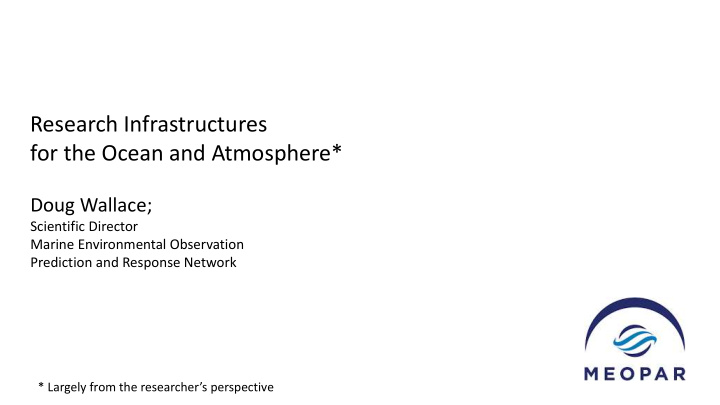



Research Infrastructures for the Ocean and Atmosphere* Doug Wallace; Scientific Director Marine Environmental Observation Prediction and Response Network * Largely from the researcher’s perspective
Premise for Session 1C: “ With the exception of a few very large scale research facilities, almost all research infrastructures are essentially national .” In the case of ocean and atmospheric research: why is this? Modelled Winds (Community Earth System Model; 0.25 ◦ ) Modelled Ocean Surface Currents and Temperature Argonne National Lab. and NCAR ECCO2 ca. 18 km resolution; NASA Visualization Lab
Research into the behaviour of the shared ocean and atmospheric environment makes a compelling case for international research infrastructures. International law envisions mechanisms for research infrastructure sharing/ transfer and use. UN Convention on the Law of the Sea (UNCLOS) calls explicitly for: “ international cooperation . . . through existing bilateral, regional or multilateral programmes, and also through expanded and new programmes in order to facilitate marine scientific research, the transfer of marine technology, particularly in new fields, and appropriate international funding for ocean research and development .”
Yet, most ocean and atmosphere research infrastructures remain “national”. Including research vessels designed for working in “areas beyond national jurisdiction”. Motivations then: Scientific exploration/ cataloguing/ etc. Naval interests, ASW, etc. “Flying the flag”; colonialism Direct support for natl. economies/ industries More recent motivations: Safety/ operational forecasting Climate change/ mitigation assessment Biodiversity/ ecosystem management Challenger: 1872-1876 Meteor: 1925-1927 Pollution on global scales
Premise: National, centralized infrastructures are poorly suited for modern large-scale ocean and atmosphere research. Consequently, the research infrastructure situation is changing: • Growing number of multilateral, shared infrastructures • Tendency towards widely-distributed systems • Global coverage; continuous operation
Contributions from 30 countries
Issues to consider: • Most current examples are single-discipline (= missed opportunities) • Funding mechanisms are complex, ad-hoc and variable • (Severe) barriers to international funding are counter-productive • Need to work with developing countries and indigenous peoples • Planning process is too cumbersome and slow. Opportunities: Science diplomacy: “The culture of science can break down national barriers and help make the world a better place. This requires shared infrastructures.” (very loosely paraphrased from Prof. Yuri Balega, yesterday)
Current time horizons for infrastructure planning are too long!!! 30 years
Research institutions are often key to planning, operation and the use of large, complex infrastructures (“national labs”). Are our research institution structures up to the task? Up-to-date? Do we need multinational or transnational research institutions that can: • React to global imperatives (more rapidly and strategically than inter- governmental organizations)? • Lead the institutional push and heavy-lifting for development and operation of major, international infrastructures A transnational corporation…..does not identify itself with one national home. While traditional multinational corporations are national companies with foreign subsidiaries, transnational corporations spread out their operations in many countries to sustain high levels of local responsiveness. (Wikepedia)
Two multi- disciplinary “proto - structure” examples.
Cabo Verde Infrastructure Transnational institution?
Transnational Institution Infrastructures?
summary • Distributed, international infrastructures are the way of the future • They were envisioned by the Law of the Sea in 1982 • Existing intl. structures are, generally, underfunded and sometimes cumbersome • Most “real” support for infrastructure remains national or single discipline • Good examples exist but templates need to be systemized, compared (beyond Europe) and made available across disciplines. • Need for new structures (including transnational research institutes) • Can be a powerful vehicle for science diplomacy
Recommend
More recommend